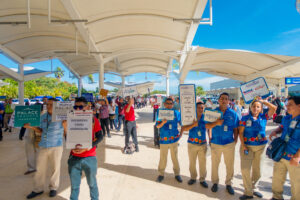
4 Reasons Why Airfares in Mexico are Pricey in Summer
Summer is approaching, and travelers are eyeing Mexico’s vibrant scenes and rich culture. Mexico is a summer vacation hotspot from Cancun’s sunny shores to Mexico City’s historic charm and Oaxaca’s culinary gems.
But the excitement for your dream getaway might be tempered by high airfare prices. Knowing why prices soar this season is key for savvy travelers looking to outsmart the flight booking game.
This article explains the main reasons for the summer price surge and offers tips on how to save more on bookings, making your dream vacation a reality.
1. High demand for travel among locals and tourists
During the summer, Mexico experiences a significant increase in travel demand, largely due to vacations and holidays. This is when many people, including families, students, and workers, have time off and choose to travel.
The warm weather and extended daylight hours also make summer an appealing time for tourists to explore new destinations.
Several specific events and festivals in Mexico contribute to the high demand for travel during this season.
These include:
- Guelaguetza Festival. Held in Oaxaca on the last two Mondays of July, this festival celebrates the region’s indigenous cultures, featuring traditional dance, music, and costumes.
- Guanajuato International Film Festival. This festival, which takes place from July 21 to 30, attracts cinema enthusiasts worldwide to the culturally rich city of Guanajuato.
- Jornadas Villistas. This week-long festival starts around July 20 in Hidalgo del Parral, Chihuahua, and commemorates the historical figure Pancho Villa with cultural events and rodeos.
- Whale Shark Festival. Celebrated in Isla Mujeres in July, this festival highlights the annual gathering of whale sharks and promotes the conservation of these gentle giants.

2. Weather challenges that may cause delays and cancellations
Summer in Mexico is not only a time of high travel demand but also coincides with the Atlantic hurricane season, which typically runs from June to November. This period poses unique challenges for air travel, significantly impacting flight schedules and airfare prices.
Hurricanes and tropical storms can lead to significant disruptions in flight operations. Airports may temporarily close, and flights can be delayed or canceled to ensure passenger safety.
For instance, destinations like Cancun, Cozumel, and other coastal areas in the Yucatán Peninsula are particularly susceptible to such weather events. The unpredictability of these storms requires airlines to adjust their operations dynamically, often at short notice, which can disrupt travel plans extensively.
When flights are canceled or delayed due to weather, the number of available seats decreases. Once operations resume, there’s a surge in demand for the limited seats available, which can lead to an increase in prices.
Additionally, airlines may incur extra operational costs during the hurricane season, including fuel needed for rerouting flights, accommodations for stranded passengers, and overtime pay for staff. These costs are often passed on to consumers through higher ticket prices.
3. Endless changes in government and airport policies
Government and airport policies significantly influence airfare prices. Ever-changing updates in fees and regulations have notably bumped up travel costs in Mexico, particularly during the bustling summer season.
The Mexican government has taken specific actions that impact airline operations, indirectly influencing airfare prices. One significant action has been regulating flight slots at congested airports.
For instance, the government has implemented measures to reduce the number of flights at major airports like AICM to alleviate congestion and reduce delays. While these measures can improve operational efficiency and reduce costs associated with delays, they also limit the number of available flights, which can drive up prices due to reduced supply.
Airport fees play a big part in air travel costs, covering everything from landing to passenger services. Recently, some Mexican airports, including the bustling Mexico City International Airport (AICM), have tweaked their fee structures. These changes often lead to higher ticket prices as airlines pass the increased costs onto travelers. On the rare occasion fees drop, ticket prices might dip too.
The airport usage tax or TUA at AICM is one of the highest in the world, with domestic flights being charged 503.22 pesos and international flights 955.49 pesos on average in 2023. For 2024, the TUA will be US $28.95 for domestic passengers and $54.96 for international passengers.

4. Limited flight options and increased operational costs
High airfare often results from limited flight options, a challenge amplified during peak seasons like summer due to staffing shortages. Shortages in pilots and attendants mean fewer flights, creating a scenario where more travelers vie for fewer seats, pushing prices up.
Regulated flight limits might also be implemented at congested airports to ease traffic and delays, further tighten seat availability, and push fares higher.
Fuel and maintenance are also big-ticket items in airline operations, directly affecting ticket prices. Fuel costs swing with global market shifts and geopolitical events, often forcing airlines to adjust fares in response.
Meanwhile, maintenance demands grow with fleet age and evolving safety standards, injecting additional costs that passengers ultimately bear.
Tips to finding better airfare deals
Looking for affordable flights to Mexico this summer? Here are some top tips to land those sweet airfare deals:
- Choose off-peak times. Fly mid-week (Tuesday and Wednesday) or during early morning and late evening hours to enjoy lower fares and a quieter experience.
- Travel during less busy seasons. Late April to early June and late September to early November are your sweet spots. Enjoy great weather, fewer crowds, and better deals.
- Keep an eye on airfare. Use tools like Google Flights or Skyscanner to set alerts for price drops on your desired route.
- Consider package deals. Look for bundled offers on flights, hotels, and car rentals. These can offer significant savings, especially for resort destinations like Cancun or Los Cabos.
Smart planning can lead to big savings and a smoother trip.
Plan with Holibay for a stree-free travel
Navigating airfare pricing is key for your summer adventure in Mexico. The mix of peak travel demand, weather variables, policy shifts, and operational costs means prices can soar. Yet, with enticing summer events and prime destinations on the line, it’s all about smart planning to keep costs down.
Dreaming of a hassle-free getaway? With Holibay, you’re set for the best. Book your summer escape now and indulge in unbeatable deals on hotel packages. From stunning beaches to delectable cuisine and vibrant culture, Mexico awaits.
Don’t wait—start your unforgettable adventure today.




